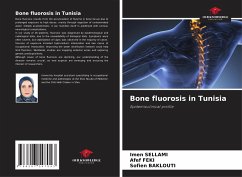Bone fluorosis results from the accumulation of fluorine in bone tissue due to prolonged exposure to high doses, mainly through ingestion of contaminated water. Initially asymptomatic, it can manifest itself in adulthood with serious neurological complications.In our study of 18 patients, fluorosis was diagnosed by epidemiological and radiological data, due to the unavailability of biological data. Symptoms were often severe, but stabilization of signs was observed in the majority of cases. Sources of exposure included hydro-telluric intoxication and two cases of occupational intoxication. Improving the water distribution network could help limit fluorosis. Worldwide, studies are mapping endemic areas and exploring genetic predispositions.Although cases of bone fluorosis are declining, our understanding of the disease remains crucial, as new aspects are emerging and arousing the interest of researchers.
Bitte wählen Sie Ihr Anliegen aus.
Rechnungen
Retourenschein anfordern
Bestellstatus
Storno








